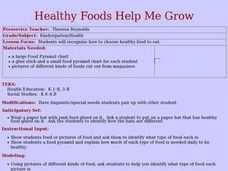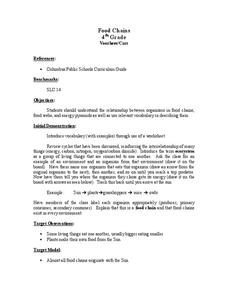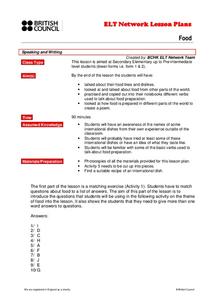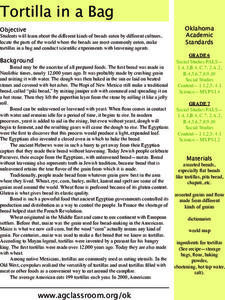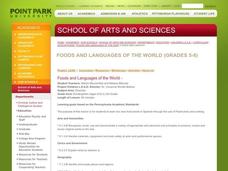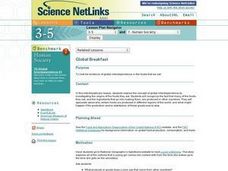Curated OER
An Introduction to Nutrition
Whether you need a new textbook for your health class, or a few exercises and passages for your lesson on nutrition, you'll find what you need with a thorough nutritional science resource. With 15 chapters that cover elements of...
Curated OER
Healthy Foods Help Me Grow
Students reconize how to choose healthy food and about why they need to eat healthy.
Curated OER
The Five Food Groups - Introduction to Nutrition
Students study the five food groups as an introduction to nutrition. In this nutrition instructional activity, students learn about which foods belong in each of the five food groups and they determine the need to eat a healthy diet....
Curated OER
Food Chains
Fourth graders investigate food chains. They review cycles and discuss ecosystems. They select an environment and create a food chain in small groups. They write their food chain and label it for the class to evaluate. They create...
Curated OER
Food
Students, discussing/brainstorming about food likes/dislikes all around the world with vivid verbs to talk about food preparation, create an original poem on how food is prepared in different parts of the world.
Curated OER
Grocery Store Field Study
Students visit a local grocery store (not a community market) to gather information about where some commonly eaten produce items come from. Once they have collected this information, locate the countries of origin on a map and research...
Curated OER
Wow! You're Eating Geography
Middle schoolers examine patterns of food producing areas, and identify foods that are grown locally, in the U.S., and around the world. They map and graph the major food crops of their local area, the U.S., and other countries, and...
Curated OER
Urban Ecosystems 2: Why are There Cities? A Historical Perspective
Second in a series of five lessons, this lesson encourages preteens to consider cities as urban ecosystems. First, they keep a food diary for a few days. They visit the Natrional Agricultural Statistics Service website for current data...
Curated OER
Marine Ecosystems
Young scholars identify producers and consumers and construct a food chain from four marine ecosystems. They describe the delicate balance among organisms in each environment. In groups, students discuss the human activities that upset...
Curated OER
Tortilla in a Bag
An engaging, and interesting lesson of types of bread found around the world awaits your charges. In it, learners compare and contrast manjy types of breads that come from cultures all over the globe. They utilize worksheets embedded in...
Purdue University
What a Waste of Food!
Follow the life of an apple from harvest to the consumer. A three-part lesson describes the different steps to get an apple from the farmer to your kitchen and the approximate waste that happens at each step. They discuss the process and...
Consortium for Ocean Science Exploration and Engagement (COSEE)
Understanding the Food Web
Building on prior knowledge of the pervious lesson in the series, pupils explain the previous lesson to each other. Then they write a simple guide for a young child to read on the same topic.
Curated OER
Food Sources
Students develop a working vocabulary of food by categorizing foods by their sources or origins. Working in groups, they determine at least four ways in which food is grown or produced. Groups create a poster by diving selected food...
Curated OER
Ways to the Heart: Food and Foodways in Hawai'i
Young scholars explore the Hawaiian culture through food. In this cultural appreciation lesson, students use map skills to locate where the food originated. They also discuss the importance of food to a culture's heritage, and prepare a...
Curated OER
Population and Food Supply
What does it mean for something to grow exponentially, and how does that compare to linear growth? This activity tries to help learners gain an understanding of these concepts while modeling real-world problems. Linear and exponential...
Curated OER
Agriculture in Your Life
Learners explore the origins of food and other everyday products around the United States. In this agricultural lesson, students learn basic vocabulary and practice matching common items with their agricultural source. They categorize...
Curated OER
Foods and Languages of the World
Students review Mexico's location and language and learn to pronouns 10 new Spanish food words. Students listen as the book, Corn is Maize is read, touching and passing around an ear of Indian corn. Students discuss the contribution of...
Curated OER
Global Breakfast
Students explore different cultures. For this global interdependence lesson, students discuss how food is produced and distributed. Students discuss different cultures and foods they eat. Students search the National Geographic website...
Curated OER
Soul Food
Students identify foods that they associate with different cultural groups in which they are members and speculate possible connections between specific foods and the cultures in which they are popular. They also explore the importance...
Curated OER
Where Does Food Come From?
Students recognize that food we eat comes from farms. In this where does food come from lesson, students discuss planting crops and how they grow. Students plant seeds for edible crops and eat them when are ripe. Students sing a song...
Curated OER
Monthly Cost of Living - Food
Pupils determine how much they would need to feed a family for a month. They plan meals and use Internet grocery stores to find the cost of individual food items. They brainstorm in small groups to come up with 1 weeks worth of menus.
Scholastic
Columbus Day/Thanksgiving Ships at Sea
Discover the meaning of Columbus Day and/or Thanksgiving by creating art from food. This activity focuses on making edible ships using easy to find food items. The class will investigate the journeys that were taken for either of these...
Curated OER
Komm mit! Our Vacation
Students study the German language. They research in small groups and create a Power Point presentation, write an essay with 15 sentences in German, prepare a food or wear a costume, and give an oral presentation.



